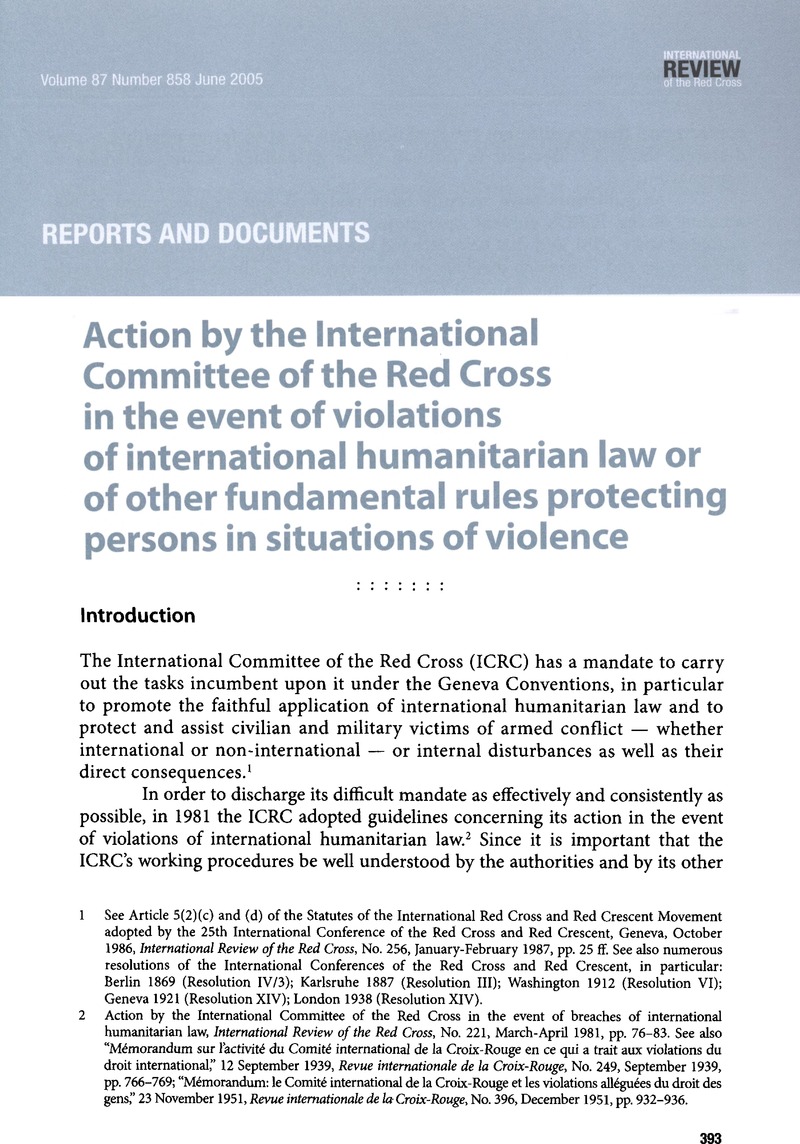Article contents
Action by the International Committee of the Red Cross in the event of violations of international humanitarian law or of other fundamental rules protecting persons in situations of violence
Published online by Cambridge University Press: 27 April 2010
Abstract

- Type
- Reports and documents
- Information
- Copyright
- Copyright © International Committee of the Red Cross 2005
References
1 See Article 5(2)(c) and (d) of the Statutes of the International Red Cross and Red Crescent Movement adopted by the 25th International Conference of the Red Cross and Red Crescent, Geneva, October 1986, International Review of the Red Cross, No. 256, January-February 1987, pp. 25 ff. See also numerous resolutions of the International Conferences of the Red Cross and Red Crescent, in particular: Berlin 1869 (Resolution IV/3); Karlsruhe 1887 (Resolution III); Washington 1912 (Resolution VI); Geneva 1921 (Resolution XIV); London 1938 (Resolution XIV).
2 Action by the International Committee of the Red Cross in the event of breaches of international humanitarian law, International Review of the Red Cross, No. 221, March-April 1981, pp. 76–83. See also “Mémorandum sur l'activité du Comité international de la Croix-Rouge en ce qui a trait aux violations du droit international,” 12 September 1939, Revue internationale de la Croix-Rouge, No. 249, September 1939, pp. 766–769; “Mémorandum: le Comité international de la Croix-Rouge et les violations alléguées du droit des gens,” 23 November 1951, Revue internationale de la Croix-Rouge, No. 396, December 1951, pp. 932–936.
3 Where international humanitarian law does not formally apply, the ICRC acts on the basis of Guideline 3.1 above in responding to violations of other fundamental rules protecting persons in situations of violence.
4 See International Court of Justice, Case Concerning Military and Paramilitary Activities in and against Nicaragua, Merits, Judgment of 27 June 1986, I.C.J. Reports 1986, para. 220. See also International Humanitarian Law and the Challenges of Contemporary Armed Conflicts, report prepared by the International Committee of the Red Cross, 28th International Conference of the Red Cross and Red Crescent, 2–6 December 2003, pp. 22 and 48 ff.
5 The ICRC has repeatedly drawn public attention to the scope of Article 1 common to the Geneva Conventions and has regularly reminded States of their obligations under this provision. See, for example, Bugnion, F., The International Committee of the Red Cross and the Protection of War Victims, ICRC/Macmillan, Oxford/Geneva, 2003, pp. 924–925.Google Scholar
6 Common Article 1 does not provide the legal basis necessary to justify recourse to armed force. Whatever its motivation, such recourse is governed by the Charter of the United Nations (see Article 89 of Additional Protocol I).
7 Where international humanitarian law does not formally apply, the ICRC actson the basis of Guideline 3.3 above in responding to violations of other fundamental rules protecting persons in situations of violence.
8 The term “quasi-judicial authority” refers to mechanisms which, although not of a judicial nature as such, have similar objectives, such as truth commissions.
- 13
- Cited by


